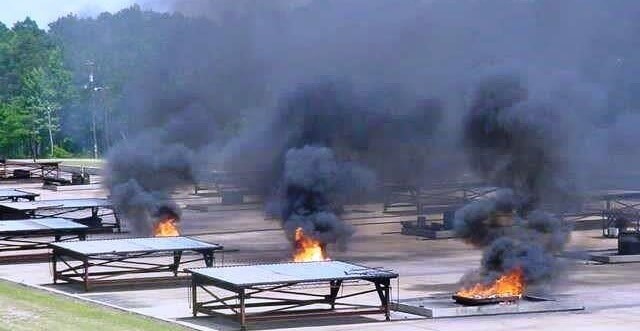
With President Obama’s signature on the 2017 National Defense Authorization Act, a nationwide grassroots campaign to ensure the safe disposal of our nation’s conventional munitions stockpile secured a key victory. The amendment, written by U.S. Senator Tammy Baldwin (D-WI), will benefit hundreds of communities across the country where open air burning of hazardous waste is routinely conducted by the Departments of Defense and Energy.
“I have been working on cleaning up the Badger Army Ammunition Plant since I first entered Congress, so I was proud to fight for this reform to help other communities facing similar challenges,” said Senator Baldwin. “This provision will assist the military in using safer and more environmentally-friendly technologies to properly dispose of munitions to ensure that other sites are not contaminated the way that the Badger site was.”
“I was proud to support and help shepherd through the Senate, the FY 2017 National Defense Authorization Act which includes a provision important to Madison County and the Blue Grass Army Depot community allowing the Army to use cost-competitive technologies to safely and efficiently dispose of stockpiles of legacy conventional munitions,” said U.S. Senator Mitch McConnell (R-KY).
“Senator McConnell’s deep involvement with finding safer alternatives for destroying chemical provided him with a clear understanding of the viability of exploring advanced more protective approaches to conventional munitions disposal,” said Craig Williams, Project Director with Kentucky Environmental Foundation.
The new Act requires the Secretary of the Army to enter into an arrangement with the National Academies of Sciences, Engineering, and Medicine to conduct a study of the alternatives to the current practice of open burning the conventional munitions stockpile of the U.S. Department of Defense.
The Department of Defense manages conventional ammunition that includes items ranging from small arms cartridges to rockets, mortars, and artillery to tactical missiles. As of February 2015, the stockpile of conventional ammunition awaiting demilitarization and disposal was approximately 529,373 tons. By fiscal year 2020, the stockpile is expected to more than double, making the proper management and disposal of such large quantities of explosive materiel critical.
“Open burning and detonation of munitions causes the uncontrolled dispersion of toxic heavy metals including chromium and lead, energetic compounds, perchlorate, nitrogen oxides and other munitions-related contaminants to the environment,” said Laura Olah, Executive Director of Citizens for Safe Water Around Badger in Wisconsin and an organizer with the Cease Fire Campaign – a national grassroots coalition of 60 environmental, labor, veterans and social justice organizations calling for safer alternatives.
“The open burning of hazardous waste poses health risks to soldiers, veterans, defense workers and communities,” said Jane Williams, Executive Director of California Communities Against Toxics. “In California, the China Lake Naval Air Weapons Station has a permit to open air burn/detonate up to 5,475,000 pounds of hazardous waste per year. Identifying new technologies that reduce the emissions from this practice is long overdue.”
Sites like the Holston Army Ammunition Plant in Tennessee are currently permitted to open burn as much as 1,250,000 pounds net explosive waste per year – ignoring a 2012 Army Corps of Engineers study that concluded there are cutting-edge technologies that could be successfully deployed at Holston to replace open burning.
“There are over 100 hazardous chemicals released from open burning waste explosives and explosives-contaminated construction demolition debris that can be toxic and carcinogenic,” cautioned Connie & Mark Toohey with Volunteers for Environmental Health and Justice and residents living downwind of Holston. “Dioxins are highly toxic and cause cancer, reproductive and developmental problems, damage to the immune system and can interfere with hormones.”
“Thousands of citizens came together in my community in north Louisiana to stop a proposed open burn of 15 million pounds of waste munitions and through the Camp Minden Dialogue Committee we proved that alternatives to open burning exist,” said Frances Kelly, Director of Organizing with Louisiana Progress Action. “With this new National Academy of Sciences study of the advanced treatment technologies, we are hopeful that open burning of hazardous waste will soon be stopped everywhere.”
For over sixty years the U. S. military used the offshore Island of Vieques, Puerto Rico for training exercises with live bombing, experimental use of conventional and non-conventional weapons, testing with napalm, agent orange, uranium, and open burning and open detonation (OB/OD),” said Myrna Pagan with Vidas Viequenses Valen. “For over ten years now there is a process of cleanup and restoration underway where OB/OD continues to contaminate this small island.”
“OB/OD is a dangerous, toxic and outdated method that feeds a health crisis of alarming rates of cancer and other catastrophic diseases,” Myrna added. “Our little children, our teen agers have more than three times the probability of dying from cancer than their peers in the rest of Puerto Rico. We citizens depend on responsible action from the government to protect our rights to good health in a safe environment. We deserve the use of reliable, alternative, advanced technologies to repair this disaster.”
The National Academy of Sciences study is due to Congress in 18 months.
* * *

